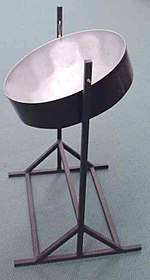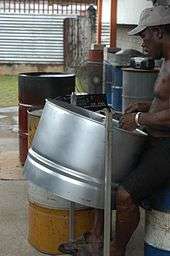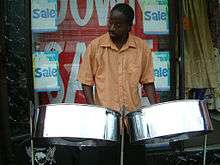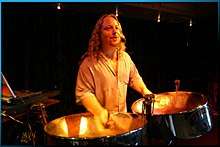Steelpan
Steelpans (also known as steel pans, steel drums or pans, and sometimes, collectively with other musicians, as a steel band or orchestra) is a musical instrument originating from Trinidad and Tobago. Steelpan musicians are called pannists.
 | |
| Percussion instrument | |
|---|---|
| Other names | Steel drum, pan |
| Classification | Percussion |
| Hornbostel–Sachs classification | 111.241.12, 111.241.22 (Gongs with divided surface sounding different pitches, Sets of gongs with divided surface sounding different pitches) |
| Developed | 1880–1937 |
| Playing range | |
| G1–F6 | |
The modern pan is a chromatically pitched percussion instrument made from 55 gallon industrial drums.
Drum refers to the steel drum containers from which the pans are made; the steel drum is more correctly called a steel pan or pan as it falls into the idiophone family of instruments, and so is not a drum (which is a membranophone). Steelpans are the only instruments made to play in the Pythagorean musical cycle of fourths and fifths.
The pan is struck using a pair of straight sticks tipped with rubber; the size and type of rubber tip varies according to the class of pan being played. Some musicians use four pansticks, holding two in each hand.[1] This skill and performance have been conclusively shown to have grown out of Trinidad and Tobago's early 20th-century Carnival percussion groups known as Tamboo bamboo. The pan is the national instrument of Trinidad and Tobago.
Origin
French planters and their slaves immigrated to Trinidad during the French Revolution (1789) from Martinique, including a number of West Africans, and French creoles from Saint Vincent, Grenada, Saint Lucia and Dominica, establishing a local community before Trinidad and Tobago were taken from Spain by the British. The celebration of carnivale had arrived with the French. Slaves, who could not take part in carnival, formed their own parallel celebration called canboulay.
Stick-fighting and African percussion music were banned in 1880, in response to the Canboulay Riots. They were replaced by bamboo sticks beaten together, which were themselves banned in turn. In 1937 they reappeared in Laventille, transformed as an orchestra of frying pans, dustbin lids, and oil drums. These steelpans are now a major part of the Trinidadian music scene and are a popular section of the Canboulay music contests. In 1941, the United States Navy arrived on Trinidad. The pannists, who were associated with lawlessness and violence, helped to popularize steelpan music among the soldiers, which began its international popularization. Steelpan playing was strictly a male activity until the late 1970s/early 1980s. It was not seen as an appropriate activity for women. At the time of the steelpan's popularity in Trinidad it was seen as being associated with a violent or derelict crowd. It was unacceptable for women to be involved in such activities. Culturally the stigma was focused on the idea that women belonged in the home or with the children and not out in the street with the pan players. As the instrument became more mainstream women were allowed to join and the stigma that went along with playing the instrument subsided. [2] [3]
The first instruments developed in the evolution of steelpan were Tamboo-Bamboos, tunable sticks made of bamboo wood. These were hit onto the ground and with other sticks in order to produce sound.[4] Tamboo-Bamboo bands included percussion of a (gin) bottle and spoon. By the mid-1930s, bits of metal percussion were being used in the tamboo bamboo bands, the first probably being either the automobile brake hub "iron" or the biscuit drum "boom". The former replaced the gin bottle-and-spoon, and the latter the "bass" bamboo that was pounded on the ground. By the late 1930s their occasional all-steel bands were seen at carnival, and by 1940 it had become the preferred carnival accompaniment of young underprivileged men. The 55-gallon oil drum was used to make steelpans from around 1947. The Trinidad All Steel Percussion Orchestra (TASPO), formed to attend the Festival of Britain in 1951, was the first steelband whose instruments were all made from oil drums. Members of TASPO included Ellie Mannette and Winston "Spree" Simon. Hugh Borde led the National Steel Band of Trinidad & Tobago at the Commonwealth Arts Festival in England, as well as the Esso Tripoli Steel Band, which played at the World's Fair in Montreal, Canada, and later toured with Liberace. They were featured on an album with him.[5]
Evolution and developments
Anthony Williams designed the "fourths and fifths" arrangement of notes, known as the cycle of fifths. This has become the standard form of note placement for lead pans. Other important developments include the tuning of harmonic overtones in individual notes, developed simultaneously and independently by Bertie Marshall and Alan Gervais.
The Caribbean Research Institute CARIRI investigated possibilities to mass-produce raw forms with the use of pressing machines in the 1970s. Much of this project took place in Sweden in collaboration with the Saab Company. Although first results were promising, the project has been abandoned due to lack of finances and support by local pan tuners in Trinidad. Another method of shaping the pan was attempted: by spinning. The pan was spun on a lathe-like device, and a roller on the end of a bar was used to sink the pan. While this did create pre-sunk pans, a problem was that there would often be scratches and grooves in the steel.
Since the steel is stretched and thin, any scratch will expand and often crack. Usually, drums have lettering embossed into the bottom. If done carefully, these can sometimes be stretched without breaking, but cracks around lettering on some drums is common. To avoid this problem, makers position the inner notes to avoid most of the letters. Brazing over the holes and grinding, will often fix the problems, without damaging the sound, but it has to be done nearly at the end of the sinking process and well before any final shaping.
A Swiss steelpan manufacturer (PANArt) researched the field of fine-grain sheet steel and developed a deep-drawn raw form which was additionally hardened by nitriding. This process, and the new instruments they called pang, were presented at the International Conference of Steel pan and Science in Port-of-Spain in 2000.[6]
Electronic steelpans have also been developed. One such version is the E-Pan,[7] invented by Salmon Cupid, who holds utility patents for it.[8] Another is the Percussive Harmonic Instrument (PHI).[9]
Construction

The note's size corresponds to the pitch—the larger the oval, the lower the tone.[10]
The size of the instrument varies from one pan to another. It may have almost all of the "skirt" (the cylindrical part of the oil drum) cut off and around 30 soprano-range notes. It may use the entire drum with only three bass notes per pan, in which case one person may play six such pans. The length of the skirt generally corresponds to the tessitura (high or low range) of the drum. The pans are usually either painted or chrome plated. Other processes such as nickel plating, powdercoating, or hardening can also be applied as a finish.
Despite being a relatively new member of the percussion family, steelpan tuning techniques have advanced rapidly. Strobe tuners are ideally suited for the task. The need to see the first few overtones further makes a strobe tuner a necessity for steelpan tuning. Steelpan makers have used strobe tuners since it was discovered that, by adjusting the overtones (first (fundamental), second, and third partial), the pan's sound seemed to sparkle in a way that it did not previously.
There are several ways in which a steelpan may become out of tune (most commonly this is caused by playing the steelpan with excessive force and incorrect handling) and it is quite common that steelbands arrange to have their instruments tuned once or twice a year. A tuner must have great skill in his/her work to manage to make the notes sound both good and at the correct pitch. Much of the tuning work is performed using hammers.
Classification
In the beginning of the steelband movement, players would play a single pan only, now commonly called around the neck instruments. Later on, some steelpans became chromatic by using multiple pans, particularly for the bass registers, which have fewer notes per pan owing to the larger sizes of the lower note areas. Following are some of the most popular instruments:
| Instrument | Pitch | Inventor |
|---|---|---|
| Single Tenor, or Ping Pong[11] | Soprano | Winston "Spree" Simon |
| Spiderweb Lead | Soprano | Tony Williams |
| Invader Lead | Soprano | Ellie Mannette |
| Double Tenor | Mezzo-soprano | Bertie Marshall |
| Double Second | Alto | Ellie Mannette |
| Double Guitar | Baritone | Jonathan Francis |
| Quadrophonic (four pans) | Baritone | Rudolph Charles[12] |
| Quadduet | Baritone | Ellie Mannette |
| Triple Guitar | Baritone | Ellie Mannette |
| Cello | Baritone | Ellie Mannette |
| Tenor Bass | Bass | Ellie Mannette |
| Six Bass | Bass | Ellie Mannette |
| Nine Bass | Bass | Rudolph Charles[12] |
| Twelve Bass | Bass | Rudolph Charles[12] |
Music and competitions

The repertoire of the steelband is extensive. Steelbands in Trinidad have a tradition of re-interpreting the current year's calypsos for carnival performance; rarely will a calypso from a previous year be heard at carnival or the Panorama music competition. Bands that perform all year round (both in Trinidad and in the so-called 'pan diaspora') have long prided themselves on being able to perform many types of music, particularly Latin and jazz numbers, film music and other popular tunes. Pannists also have a tradition of performing classical music which dates back to 1946, both in calypso tempo (known as "The Bomb") and straight (generally in concert or music festival contexts). In these contexts, accuracy and faithfulness to the original are highly prized.[13] While many American and British audiences demand to hear Harry Belafonte songs on pan, these are generally inauthentic to the Trinidadian tradition.
For many years now there have been attempts to use the steelpan in various contexts other than those with which it is stereotypically associated. The first known use of steelband in a theatrical performance (outside of Trinidad and Tobago) was in Harold Arlen's 1954 Broadway musical House of Flowers, in which Enid Mosier's Trinidad Steel Band performed in several songs. British composer Daphne Oram was the first composer to electronically manipulate the sound of the steelpan after recording a band (probably Russell Henderson's Steelband) in 1960.[14] The first use of pan in a commercial pop record was by The Hollies in 1967 with "Carrie Anne".[15] Loggins and Messina feature steel drums on the song "Vahevala" from their 1971 album Sittin' In.
An international festival, the World Steelband Music Festival, has been held intermittently in Trinidad since 1964, where steelbands perform a test piece (sometimes specially composed, or a selected calypso); a piece of choice (very often a "classic" or European art-music work); and calypso of choice, in a concert-style venue.[16] Panorama, the largest steelband contest in the world, occurs during Carnival celebrations in Trinidad.
Steelpans were introduced to the genre of Jazz Fusion by players such as Dave Samuels and Othello Molineaux in the 1980s, and Jonathan Scales in the 2000s. The sound of the steelpans adds a pleasant and accessible sound to an otherwise complex musical style. They are featured in the early fusion album Morning Dance by Spyro Gyra.
Nick Jonas' 2016 single "Close" features the steelpan as the musical instrument.
Pannists


A pannist (sometimes panist or panman), is a person who plays the steelpan. A professional pannist may perform solo, play with a steel band, or accompany singers or solo instrumentalists.
Pannists may play with their respective bands in large competitions,[17] and generally memorize everything that they perform.[18]
The pannist's top position in a Panorama steelband is that of the captain. These large ensembles often include section leaders: accomplished pannists that monitor the various voices in the band.[19]
Influential pannists include Ellie Mannette, the "Father of the Modern Steel Drum" and an accomplished panman, and Winston Simon, the inventor and a skilled player of the "Ping Pong" pan.
Notable pannists
- Ellie Mannette
- Winston "Spree" Simon
- Tony Williams
- Ray Holman
- Liam Teague
- Len "Boogsie" Sharpe
- Rick Henson
- Don Prorak
- Duvone Stewart
- Paul Munzenrider
- Tom Miller
- Andy Narell
- Andrew Neldon
- Keisha Codrington
- Devindra Ramautar
- Keishaun Julien
- Johann Chuckaree
- Russ Henderson
- Andy Akiho
Musicians Jimmy Buffet and Lord Kitchener are known for composing music later adapted to the steel pan. Noted pan tuners and producers include Darren Dyke, Mappo, Bertrand Kelman, and Herman Guppy.
See also
- Hang (instrument) - a similar instrument with a convex rather than concave surface
References
- Dudley, Shannon; Music from Behind the Bridge: Steelband Spirit and Politics in Trinidad and Tobago, New York City: Oxford University Press; 2007; ISBN 0-19-532123-5
- https://etd.ohiolink.edu/rws_etd/document/get/muhonors1111087466/inline
- https://www.bbc.com/news/magazine-18903131
- Saldenha, Robert (January 2002). "Another Look at the History of the Steel Band No. 1 The Evolution of the Steel Band". Sam's Newsletter. Archived from the original on 7 August 2007. Retrieved 22 February 2008.
- Van Dyke Parks: The Esso Trinidad Tripoli Steel Band; En hed is heel zwaar
- Pang instruments Archived 6 January 2009 at the Wayback Machine
- The E-pan
- Patent at US Patent Office website
- About the P.H.I. at manufacturer's website
- Williams, Krystle. "Harmony in the Caribbean: Making and Breaking the Secrets of the Steel Pan". Retrieved 22 February 2008.
- "BBC: A History of the World – Objects". Archived from the original on 9 October 2016.
- Inventions
- see Dudley (2008) and Thomas (1992)
- Wee Also Have Sound Houses; BBC Radio 3; Sunday Feature; 3 July 2008.
- Thomas; Forty Years of Steel; p.56.
- Stuempfle; The Steelband Movement; 1995; pp.164–7
- Saldenha, Robert (May 2005). "Another Look At The History of The Steel Band (No. 2 1945 - 1949)". Sam's Newsletter. Archived from the original on 8 August 2007. Retrieved 21 February 2008.
- Woodall, Carolyn (2008). "Focal Point: Steelpan - Playing in De Band". Diversity Now. Retrieved 21 February 2008.
Further reading
- Aho, William R. "Steel Band Music in Trinidad and Tobago: The Creation of a People's Music", Latin American Music Review 8 (1): 26–56, 1987.
- Blake, Felix I. R. The Trinidad and Tobago Steel Pan: History and Evolution. ISBN 0-9525528-0-9
- Dudley, Shannon K. "Judging 'By the beat': Calypso versus soca", Ethnomusicology 40 (2): 269–98, 1996.
- Dudley, Shannon K. Making music for the Nation: Competing identities and Esthetics in Trinidad and Tobago's Panorama Steelband Competition. PhD dissertation; University of California Berkeley, 353pp., 1997.
- Dudley, Shannon K. "Dropping the Bomb: Steelband Performance and Meaning in 1960's Trinidad", Ethnomusicology 46 (1): 135–64, 2002.
- Grant, Cy. Ring of Steel – Pan Sound and Symbol. Macmillan Education, London, 1999. ISBN 0-333-66128-1
- Helmlinger, Aurélie. Geste individuel, mémoire collective: Le jeu du pan dans les steelbands de Trinidad et Tobago, Cahiers de musiques traditionnelles 14 : 181–202, 2001.
- Helmlinger, Aurélie. Mémoire et jeu d'ensemble ; La mémorisation du répertoire dans les steelbands de Trinidad et Tobago. PhD dissertation; Université Paris X Nanterre, Paris, 2005.
- Helmlinger, Aurélie. "The influence of the group for the memorization of repertoire in Trinidad and Tobago steelbands". 9th International Conference on Musical Perception and Cognition proceedings, ed. by M. Baroni, A.R. Addessi, R. Caterina, M. Costa, Bologna, 2006.
- Helmlinger, Aurélie. Les steelbands de Trinidad et Tobago : Ethnomusicologie cognitive d'une mémoire d'orchestre, In Intellectica 48 (1) : 81–101, 2008.
- Helmlinger, Aurélie. Mémoriser à plusieurs. Expérience sur l’effet du groupe dans les steelbands (Trinidad et Tobago). Memorizing together. Group effect experiments in steelbands (Trinidad and Tobago). Annales Fyssen 24 : 216–235, 2010.
- Helmlinger, Aurélie. La virtuosité comme arme de guerre psychologique, Ateliers d'anthropologie, 35, 2011.
- Kronman, Ulf. Steel Pan Tuning – a Handbook for Steel Pan Making and Tuning. Part of the series, Musikmuseets skrifter, 1992. ISSN 0282-8952
- Manuel, Peter. Caribbean Currents: Caribbean Music from Rumba to Reggae, 2nd ed. Philadelphia: Temple University Press, 2006. ISBN 1-59213-463-7
- Seeger, P. Steel drums – how to play them and make them, Oak. Publ. New York, 1964.
- Stuempfle, Stephen. The steelband movement. The forging of a national art in Trinidad and Tobago, University of Pennsylvania Press, 287 pp., 1995.
- Thomas, Jeffrey. Forty Years of Steel: An Annotated Discography of Steelband and Pan Recordings, 1951–1991. Connecticut, USA: Greenwood Press, 1992.
External links
| Wikimedia Commons has media related to Steelpans. |
- Pan Trinbago
- Pan Jumbie
- Different Timbres, 1980, Archives of Ontario YouTube Channel